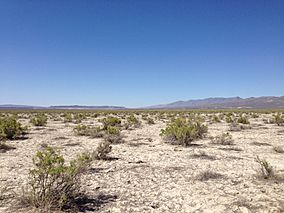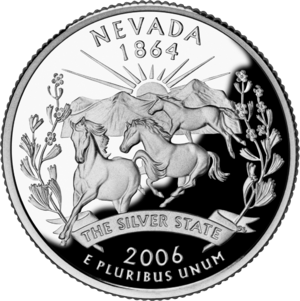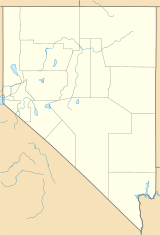Sheldon National Wildlife Refuge facts for kids
Quick facts for kids Sheldon National Wildlife Refuge |
|
|---|---|
|
IUCN Category IV (Habitat/Species Management Area)
|
|

Desert vegetation near the eastern edge of the refuge
|
|
| Location | Humboldt and Washoe counties, Nevada |
| Nearest city | Lakeview, Oregon |
| Area | 573,504 acres (232,089 ha) |
| Established | 1931 |
| Governing body | U.S. Fish and Wildlife Service |
| Website | Sheldon NWR |
The Sheldon National Wildlife Refuge is a huge protected area covering 573,504 acres (232,089 ha) (about 2,320 square kilometers). It is located mostly in northern Nevada, with a tiny part stretching into Oregon. This special place is managed by the United States Fish and Wildlife Service (USFWS).
The refuge was created in 1931 for three main reasons. First, it was meant to be a safe home for the pronghorn, an animal that looks like an antelope and was becoming rare. Second, it aimed to protect native fish, plants, and other wildlife. The refuge also includes the Virgin Valley Opal Mining District, where people still dig for beautiful opals. Third, it was set up as a safe haven for birds that travel long distances.
Sheldon is known as one of the best examples of a sagebrush steppe ecosystem in the Great Basin. This means it has a unique environment with lots of sagebrush plants. Many special animals live here, including desert fish, greater sage-grouse, different kinds of migratory birds, mule deer, and the tiny pygmy rabbit.
Did you know that a spot inside the Sheldon Refuge is the farthest place in the connected United States from a McDonald's restaurant? It's about 115 miles (185 kilometers) away!
Exploring the Sheldon Refuge
The Sheldon National Wildlife Refuge is a dry area with many volcanic rocks. The land here ranges from 4,100 feet (1,200 m) to 7,200 feet (2,200 m) above sea level. The main plants you will see are tough, drought-resistant species like sagebrush, juniper, mountain mahogany, and bitterbrush.
People have been digging for opals in the Virgin Valley since 1906. Rockhounds, or people who love collecting rocks, can find precious opals, agates, petrified wood, and other cool stones here. There are also geothermal hot springs, which are natural hot water springs. These hot springs provide water for a swimming pool and shower house in the campground.
Amazing Animals of Sheldon
This rugged landscape is home to many wild animals. The most famous is the pronghorn, which is North America's fastest land mammal. There are about 3,500 pronghorns living here.

You can also find large groups of mustangs, which are wild horses. These horses are descendants of horses once used by the U.S. Army. Ranchers like Harry Wilson used to work with the Army, breeding their horses with thoroughbred stallions. There are also many mule deer and a small group of bighorn sheep.
The bighorn sheep were not originally from the Sheldon Refuge. They disappeared from the area a long time ago but were brought back around 1930. The pronghorn played a big part in the refuge's history. About 94 percent of the land was first set aside in 1936 as the Charles Sheldon Antelope Range to protect them. The refuge is also home to a special fish called the Alvord chub, which is found only in a small area.
Getting to the Refuge
Nevada State Route 140 is the only paved road that goes through the refuge from east to west. The closest town is Denio, Nevada, which is about 14 miles from the refuge's eastern border. The nearest major highway is Interstate 80 in Winnemucca, Nevada, which is about 100 miles to the south. County Road 8A also connects to Cedarville, California.


